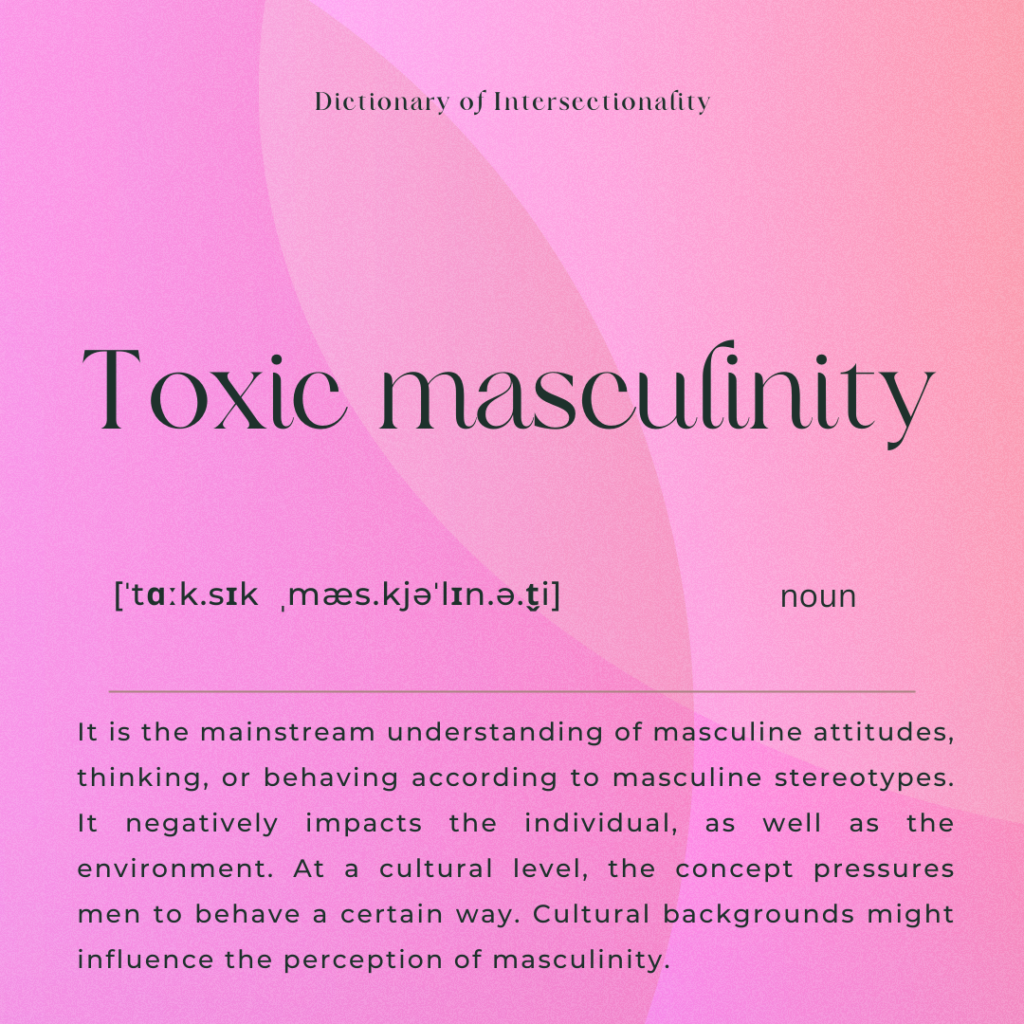
The term is loosely defined as masculine attitudes, including ways of thinking, or behaving stereotypically that negatively impact the individual, as well as the environment. At a cultural level, it pressures men to behave a certain way. Cultural backgrounds might influence the perception of masculinity.
This idea of a ‘real’ man can be harmful to their (mental) health and impacts society. Common definitions include toughness (physically strong, suppress emotions and behaviorally aggressive), antifeminist (rejection of anything that is seen to be feminine), and power (work toward obtaining power and status for respect; violence – think of desired ‘though-guy’ image).
Toxic masculinity has been tied to the concept of patriarchy (control of society by men) and often stands opposed to social justice efforts like gender, racial, and income equality.
The term has a mixed history.
First, it was an analytical concept to critique the strict masculinized gender norms with the goal of overturning them in the 90s, which were already used in therapeutic contexts earlier. In response to feminism, the term was coined in the mythopoetic men’s movement of the time. According to it, men’s aggression and frustration were the results of a society that feminized boys by denying deep masculinity.
The idea of toxic masculinity harmonized with conservative policies that socially control low-income, unemployed, or imprisoned men and support patriarchal family values. Since 2013, feminists have begun to imply misogyny, homophobia, and male violence. In 2016, various media used the term to describe the bad behavior of powerful white men (e.g., #Metoo debate) in contrast to its earlier application to marginalized men.
In January 2019, the American Psychological Association (APA) published guidelines for dealing with men and boys who exhibit “traditional masculinity”. This lends institutional legitimacy that certain gendered behaviors are socially constructed and can therefore be deconstructed. Toxic masculinity has indeed become a framework for mainstream and academic understanding of the gender factor in social issues such as privilege, sexism, violence, and prejudice.
However, some might argue that focusing on this can dismantle gender hierarchies – but it can also reinforce normative male denial of homophobia and sexism and perpetuate gender inequalities. By distancing themselves from such ‘toxic’ elements of masculinity, men can present heterosexual male privilege as a thing of the past, even as it continues to structure institutions. The distinction between “toxic” characteristics and “healthy” masculinity does not imply a rejection of gender hierarchy or a binary gender order.
Rather, it is about understanding the situations in which groups of men act, and the patterns and consequences of their actions. When the term “toxic masculinity” refers to the assertion of male privilege or male power, it hits an important point. Ordinary masculine ideals such as social respect, physical strength, or sexual potency become problematic by setting ideals. Nevertheless, they should not be seen as stable character traits.
There is no denying existing gendered patterns in violent and abusive behavior, but an important question to improve is: where do these sexist attitudes come from? We should understand that masculinity itself is not toxic and instead try to challenge the roots of toxic gendered behavior.
See more resources
Toxic Masculinity – Cambridge Dictionary. Retrieved January 12, 2023, from https://dictionary.cambridge.org/dictionary/english/toxic-masculinity
Toxic masculinity – Oxford Languages. https://languages.oup.com/google-dictionary-en/
Sam de Boise (2019). Why is Masculinity toxic? International Journal for Masculinity Studies 2019, Vol. 14, No. 3, 147–151. https://doi.org/10.1080/18902138.2019.1654742
Rob Horne and Steve Hall, ‘Anelpis: A Preliminary Expedition into a World without Hope or Potential’. Parallax 1, no. 1 (1995): 81–91. https://doi-org.abc.cardiff.ac.uk/10.1080/13534649509361995
What is Toxic Masculinity? – Amy Morin. Retrieved 16th, January, from https://www.verywellmind.com/what-is-toxic-masculinity-5075107
Toxic Masculinity – dictionary.com. Retrieved 16th, January, from https://www.dictionary.com/browse/toxic-masculinity
What is toxic masculinity? – Maya Salam. New York Times. Retrieved 16th, January, from https://www.nytimes.com/2019/01/22/us/toxic-masculinity.html
The Problem With a Fight Against Toxic Masculinity – Michael Salter, 2019. https://dickkesslerphd.com/wp-content/uploads/2019/03/The-Problem-With-a-Fight-Against-Toxic-Masculinity.pdf
Connell, R. W., & Messerschmidt, J. W. (2005). Hegemonic Masculinity: Rethinking the Concept. Gender & Society, 19(6), 829–859. https://doi.org/10.1177/0891243205278639
